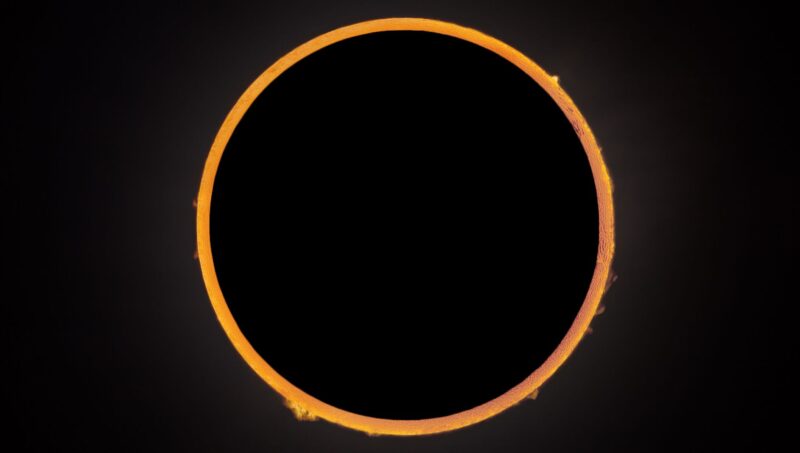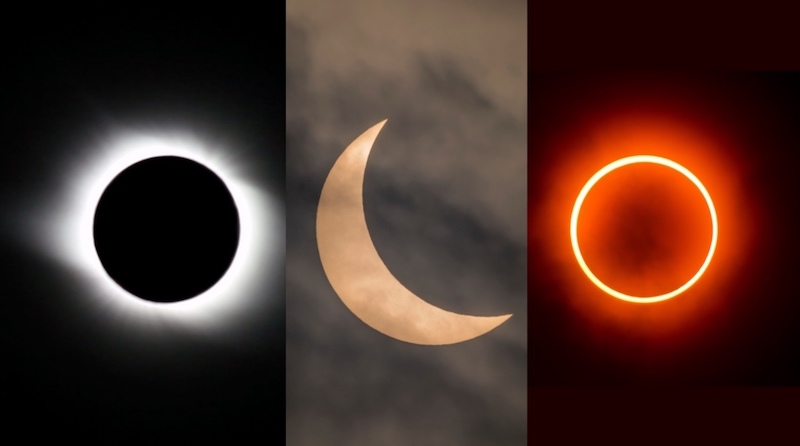
Annular solar eclipse October 2, 2024 occurs worldwide
The second solar eclipse of 2024 will be an annular – sometimes called a “ring of fire” – solar eclipse on Wednesday, October 2, 2024. The solar eclipse will be visible from parts of South America, the Pacific Ocean, the Atlantic Ocean, and Antarctica. As you can tell from the map below, most of it will be visible over the ocean.
Below are the times of the annular solar eclipse phases on October 2, 2024:
-
Partial eclipse begins at 15:42 UTC
Annular eclipse begins at 16:50 UTC
Maximum Eclipse begins at 18:45 UTC
Annular eclipse ends at 20:39 UTC
Partial eclipse ends at 21:47 UTC
For precise timing from your location check temeanddate.com.

Click here to learn how to watch a solar eclipse safely.
Animations and seeing the eclipse from your location
Watch an animation of the path of the annular solar eclipse at timeanddate.com.
Another animation of the eclipse at eclipsewise.com
For information from your location timeanddate.com
The Solar Eclipse Circumstances Calculator is an interactive web page
Why is it called an annular eclipse?
Astronomers call this an annular eclipse of the sun. In fact, that name comes from the Latin word for ring: annulus. That’s because it refers to the outer rings of the sun’s surface, visible at mid-eclipse. And, though not as dramatic as a total solar eclipse, this eclipse will be fascinating to view. You really only need to know two things. First, how much of the sun will be covered from your location? Second, what time is the eclipse from your location?
Overall, the eclipse will last 223 minutes. At maximum eclipse – for those along the center eclipse path – the sun will be just over 86 percent covered by the moon. The part of the sun that will be visible is its outer surface. So essentially, an annular eclipse is a partial eclipse, throughout the event. So remember, use eye protection! At no time will this eclipse be safe to view without some form of solar filter protection.

Overview of the October 2 annular solar eclipse path
The path of the annular eclipse will begin about 1,056 miles (1,700 kilometers) southwest of the Hawaiian Islands at 16:54 UTC. That’s where the moon’s antumbral shadow first falls on Earth forming a 205-mile-wide (331 kilometers) path. And the annular eclipse lasting there for 5 minutes and 39 seconds.
Then the annular eclipse sun will move southwest and reach greatest eclipse at 18:45 UTC with a duration of 7 minutes and 2 seconds over a path 165 miles (266 kilometers) wide. The eclipse magnitude is 0.93 with 0.87 of the sun obscured.
At 19:07 UTC, the annular eclipse will finally reach land when it passes over Rapa Nui. The remote island is 42 miles (68 kilometers) northeast of the central line, but they’ll still have 6 minutes and 23 seconds of the annular eclipse. The next land it reaches is Chile’s Patagonian coast at 20:22 UTC. The central line there is 6 minutes and 26 seconds. Crossing the Andes, the eclipse reaches Argentina at 20:24 UTC. The shadow takes a little over three minutes to cross Argentina before reaching the South Atlantic coast at 20:27 UTC.
Finally, the eclipse will pass north of the Falkland Islands, where the antumbral path ends 341 miles (550 kilometers) north of South Georgia at 20:36 UTC. In the end, the antumbral path will pass over 8,800 miles (14,200 kilometers) in 3 hours and 43 minutes. And it will cover 0.82% of the Earth’s surface area.
Meanwhile, those outside the shadow path will see a partial solar eclipse. Important: this is not a total eclipse. And the first thing to remember, at no time during this eclipse will it be safe to look at the sun without proper eye protection.
This is 2024’s 2nd solar eclipse
The first solar eclipse in 2024 – on April 8, 2024 – was a total solar eclipse whose path of totality passed over North America.

Bottom line: The October 2, 2024, annular solar eclipse will cross over parts of South America, the Pacific Ocean, the Atlantic Ocean, and Antarctica.
Read more:











